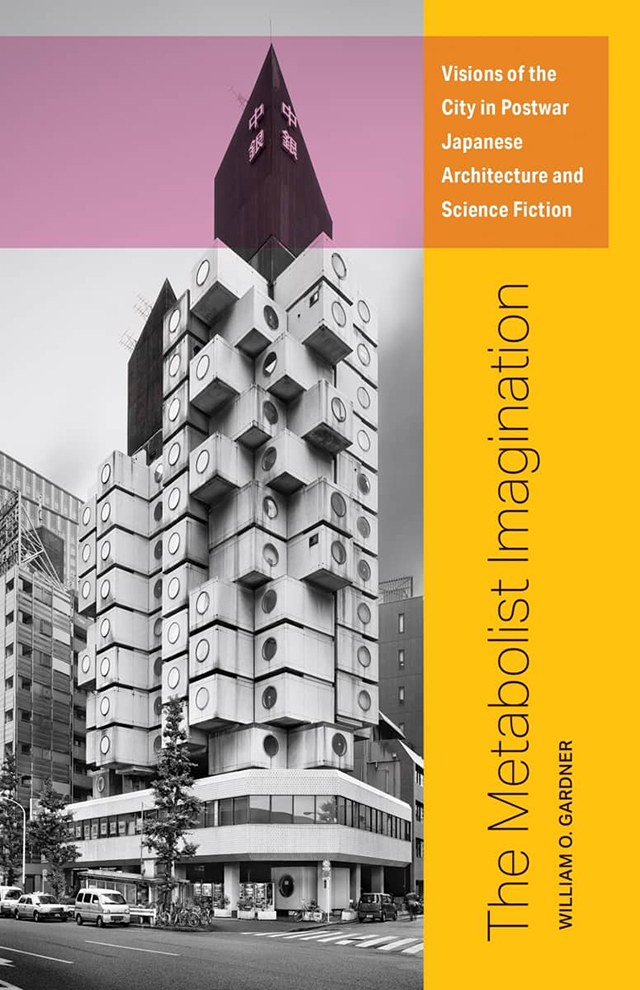The Metabolist Imagination
The Metabolist Imagination: Visions of the City in Postwar Japanese Architecture and Science FictionWilliam O. GardnerUniversity of Minnesota Press, April 2020Paperback | 5-1/2 x 8-1/2 inches | 232 pages | 20 illustrations | English | ISBN: 978-1517906245 | $27.00PUBLISHER'S DESCRIPTION: The devastation of the Second World War gave rise to imaginations both utopian and apocalyptic. In Japan, a fascinating confluence of architects and science fiction writers took advantage of this space to begin remaking urban design. In The Metabolist Imagination, William O. Gardner explores the unique Metabolism movement, which allied with science fiction authors to foresee the global cities that would emerge in the postwar era. This first comparative study of postwar Japanese architecture and science fiction builds on the resurgence of interest in Metabolist architecture while establishing new directions for exploration. Gardner focuses on how these innovators created unique versions of shared concepts—including futurity, megastructures, capsules, and cybercities—making lasting contributions that resonate with contemporary conversations around cyberpunk, climate change, anime, and more. The Metabolist Imagination features original documentation of collaborations between giants of postwar Japanese art and architecture, such as the landmark 1970 Osaka Expo. It also provides the most sustained English-language discussion to date of the work of Komatsu Sakyō, considered one of the “big three” authors of postwar Japanese science fiction. These studies are underscored by Gardner’s insightful approach—treating architecture as a form of speculative fiction while positioning science fiction as an intervention into urban design—making it a necessary read for today’s visionaries. William O. Gardner is professor of Japanese language, literature, and film at Swarthmore College. He is author of Advertising Tower: Japanese Modernism and Modernity in the 1920s. REFERRAL LINKS: dDAB COMMENTARY: Recently Netflix released Japan Sinks: 2020, a ten-part anime series about a family's "journey of survival through the sinking archipelago" after it is struck by earthquakes. The name implies the story is not new. Japan Sinks was created in 1973, as a novel by Sakyo Komatsu and a film, Tidal Wave, released the same year. The book is one of two novels by Komatsu that have been translated into English and received widespread attention; the other, Virus, came out a decade before Japan Sinks. Needless to say, with one story about a natural disaster and the other about an alien microbe nearly wiping out all of humanity, Komatsu embodied the pessimism that pervaded Japan in the decades after World War II. That Japan Sinks was made into a moving picture for the fourth time (a TV series followed the first film, and a film remake was released in 2006, when Komatsu's sequel to the novel was released), though fortuitous with our global pandemic, indicates such pessimism lingers. What does Komatsu's books have to do with Metabolism, the architectural movement often associated with Kenzo Tange, Arata Isozaki, Kisho Kurokawa, and other Japanese architects working in the 1960s and 70s? Komatsu is part of a couple chapters in William O. Gardner's eye-opening The Metabolist Imagination, one of which is devoted to the sci-fi master's "disaster fiction." I'll admit I wasn't familiar with Komatsu or his books, or even the Netflix series, before reading about them in Gardner's book. Meaning I also wasn't aware that Komatsu authored a collection of travel essays with Kurokawa, a minor link between architecture and fiction, but one that is at home in Gardner's exploration of the two fields of cultural production in Japan a half-century ago. While architects tend to consider Metabolism through its forms (megastructures and capsules, mainly), Gardner frames it as a movement focused on process, be it adaptation by users, rebuilding over time, or destruction through war or natural disaster. In this sense, Japan Sinks, Virus, and other works of fiction are strongly aligned with Metabolism. The six chapters of The Metabolist Imagination are dense and scholarly but highly enjoyable and revealing, especially for someone, like me, who likes Japanese architecture and the occasional anime. (Four of the chapters were previously published in academic journals, while a fifth was excerpted by Places Journal, for those who want a taste of the book.) Gardner connects the creations of architects and writers in Japan in the 1960s and 70s through narrative: the process-oriented Metabolists were forming narratives through their megastructures and capsules as much as writers traditionally craft stories. In turn the two groups strongly influenced each other and helped create some of the most lasting designs and stories that came out of Japan last century. The groups also converged at Expo 70, which was much more optimistic than the books of Komatsu but nevertheless saw him in

The Metabolist Imagination: Visions of the City in Postwar Japanese Architecture and Science Fiction
University of Minnesota Press, April 2020
Paperback | 5-1/2 x 8-1/2 inches | 232 pages | 20 illustrations | English | ISBN: 978-1517906245 | $27.00
PUBLISHER'S DESCRIPTION:
REFERRAL LINKS:
SPREADS:










